Understanding and Leading Change in Organizations: Marks & Spencer
VerifiedAdded on 2020/07/23
|15
|4487
|32
Report
AI Summary
This report provides a comprehensive analysis of organizational change and leadership, focusing on the case of Marks & Spencer. It explores the influence of change on organizational operations and strategies, examining both internal and external drivers, and their impacts on individuals, leadership, and teams. The report identifies measures to minimize the negative impacts of change and analyzes various barriers to change, including their influence on leadership decisions. It further assesses the application of different leadership approaches to effectively manage change. The Burke-Litwin Change Model is also discussed to understand and implement successful change within organizations. Overall, the report offers insights into effective change management and leadership practices within a real-world business context.
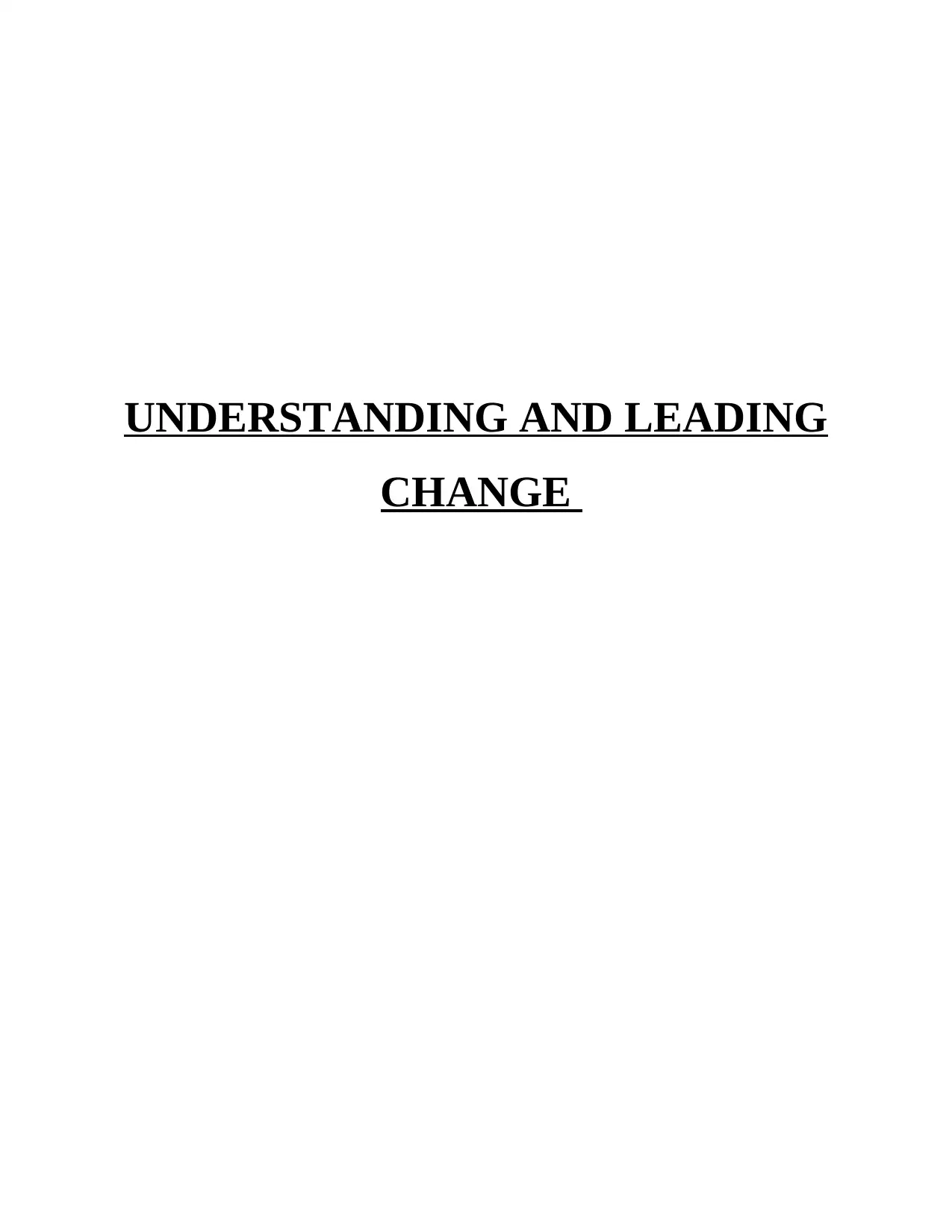
UNDERSTANDING AND LEADING
CHANGE
CHANGE
Paraphrase This Document
Need a fresh take? Get an instant paraphrase of this document with our AI Paraphraser
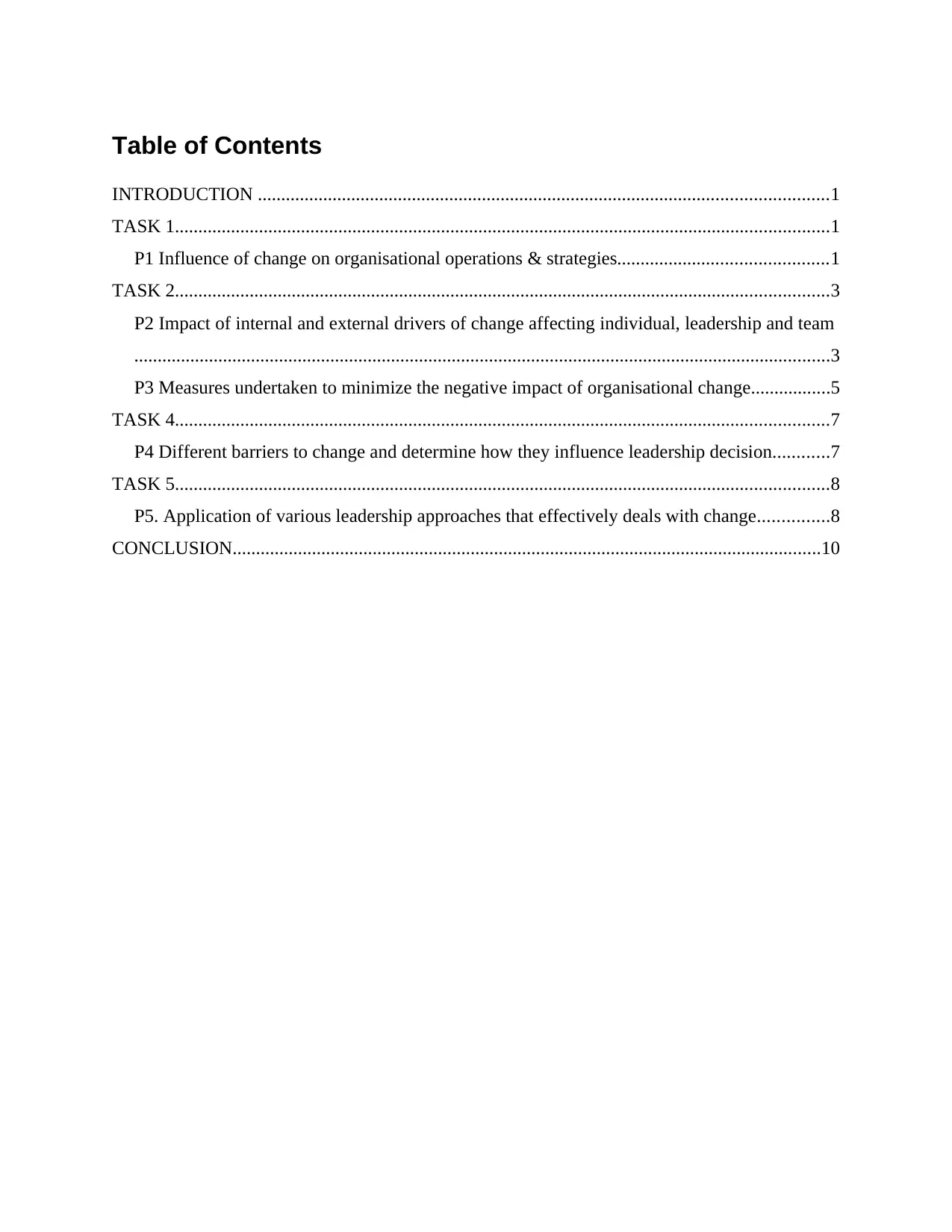
Table of Contents
INTRODUCTION ..........................................................................................................................1
TASK 1............................................................................................................................................1
P1 Influence of change on organisational operations & strategies.............................................1
TASK 2............................................................................................................................................3
P2 Impact of internal and external drivers of change affecting individual, leadership and team
.....................................................................................................................................................3
P3 Measures undertaken to minimize the negative impact of organisational change.................5
TASK 4............................................................................................................................................7
P4 Different barriers to change and determine how they influence leadership decision............7
TASK 5............................................................................................................................................8
P5. Application of various leadership approaches that effectively deals with change...............8
CONCLUSION..............................................................................................................................10
INTRODUCTION ..........................................................................................................................1
TASK 1............................................................................................................................................1
P1 Influence of change on organisational operations & strategies.............................................1
TASK 2............................................................................................................................................3
P2 Impact of internal and external drivers of change affecting individual, leadership and team
.....................................................................................................................................................3
P3 Measures undertaken to minimize the negative impact of organisational change.................5
TASK 4............................................................................................................................................7
P4 Different barriers to change and determine how they influence leadership decision............7
TASK 5............................................................................................................................................8
P5. Application of various leadership approaches that effectively deals with change...............8
CONCLUSION..............................................................................................................................10
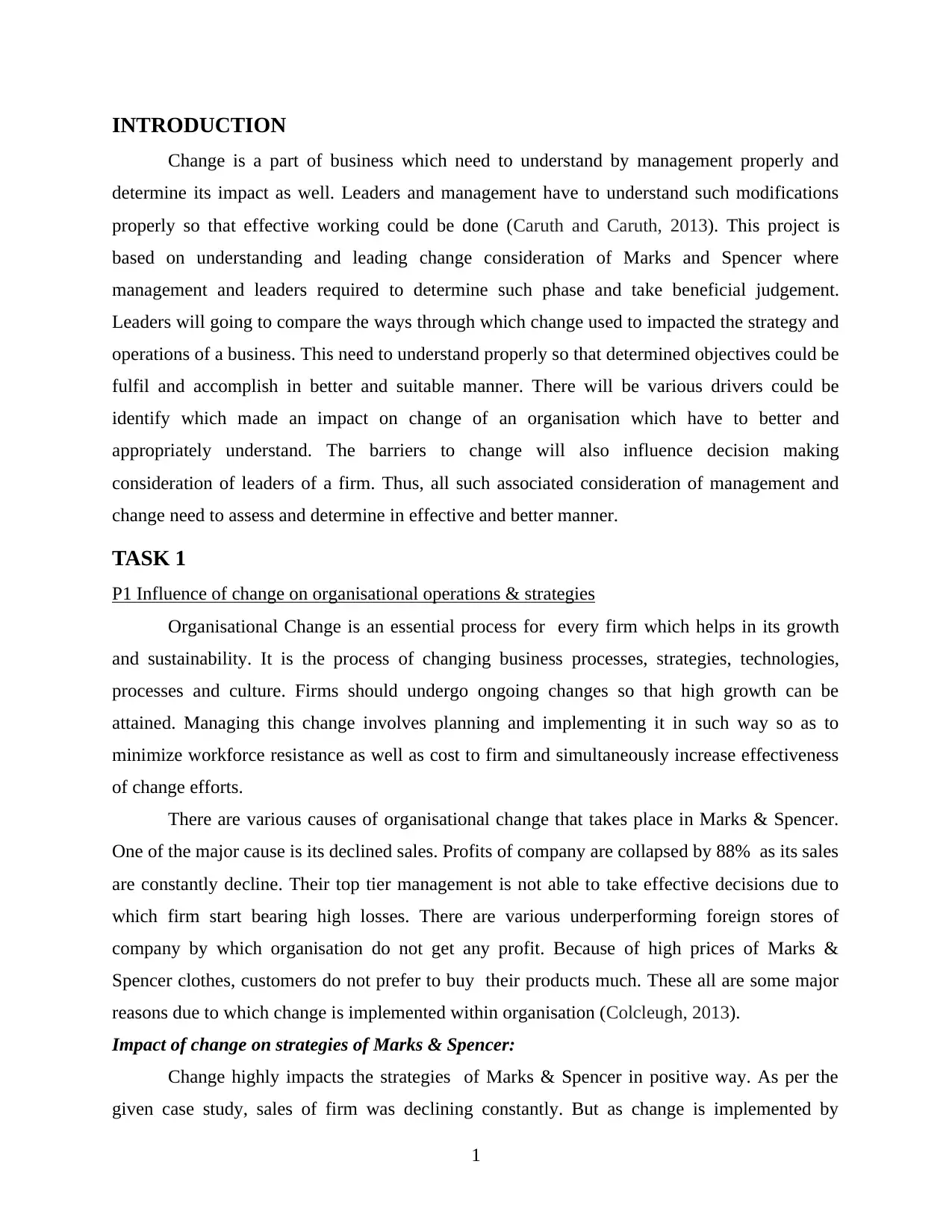
INTRODUCTION
Change is a part of business which need to understand by management properly and
determine its impact as well. Leaders and management have to understand such modifications
properly so that effective working could be done (Caruth and Caruth, 2013). This project is
based on understanding and leading change consideration of Marks and Spencer where
management and leaders required to determine such phase and take beneficial judgement.
Leaders will going to compare the ways through which change used to impacted the strategy and
operations of a business. This need to understand properly so that determined objectives could be
fulfil and accomplish in better and suitable manner. There will be various drivers could be
identify which made an impact on change of an organisation which have to better and
appropriately understand. The barriers to change will also influence decision making
consideration of leaders of a firm. Thus, all such associated consideration of management and
change need to assess and determine in effective and better manner.
TASK 1
P1 Influence of change on organisational operations & strategies
Organisational Change is an essential process for every firm which helps in its growth
and sustainability. It is the process of changing business processes, strategies, technologies,
processes and culture. Firms should undergo ongoing changes so that high growth can be
attained. Managing this change involves planning and implementing it in such way so as to
minimize workforce resistance as well as cost to firm and simultaneously increase effectiveness
of change efforts.
There are various causes of organisational change that takes place in Marks & Spencer.
One of the major cause is its declined sales. Profits of company are collapsed by 88% as its sales
are constantly decline. Their top tier management is not able to take effective decisions due to
which firm start bearing high losses. There are various underperforming foreign stores of
company by which organisation do not get any profit. Because of high prices of Marks &
Spencer clothes, customers do not prefer to buy their products much. These all are some major
reasons due to which change is implemented within organisation (Colcleugh, 2013).
Impact of change on strategies of Marks & Spencer:
Change highly impacts the strategies of Marks & Spencer in positive way. As per the
given case study, sales of firm was declining constantly. But as change is implemented by
1
Change is a part of business which need to understand by management properly and
determine its impact as well. Leaders and management have to understand such modifications
properly so that effective working could be done (Caruth and Caruth, 2013). This project is
based on understanding and leading change consideration of Marks and Spencer where
management and leaders required to determine such phase and take beneficial judgement.
Leaders will going to compare the ways through which change used to impacted the strategy and
operations of a business. This need to understand properly so that determined objectives could be
fulfil and accomplish in better and suitable manner. There will be various drivers could be
identify which made an impact on change of an organisation which have to better and
appropriately understand. The barriers to change will also influence decision making
consideration of leaders of a firm. Thus, all such associated consideration of management and
change need to assess and determine in effective and better manner.
TASK 1
P1 Influence of change on organisational operations & strategies
Organisational Change is an essential process for every firm which helps in its growth
and sustainability. It is the process of changing business processes, strategies, technologies,
processes and culture. Firms should undergo ongoing changes so that high growth can be
attained. Managing this change involves planning and implementing it in such way so as to
minimize workforce resistance as well as cost to firm and simultaneously increase effectiveness
of change efforts.
There are various causes of organisational change that takes place in Marks & Spencer.
One of the major cause is its declined sales. Profits of company are collapsed by 88% as its sales
are constantly decline. Their top tier management is not able to take effective decisions due to
which firm start bearing high losses. There are various underperforming foreign stores of
company by which organisation do not get any profit. Because of high prices of Marks &
Spencer clothes, customers do not prefer to buy their products much. These all are some major
reasons due to which change is implemented within organisation (Colcleugh, 2013).
Impact of change on strategies of Marks & Spencer:
Change highly impacts the strategies of Marks & Spencer in positive way. As per the
given case study, sales of firm was declining constantly. But as change is implemented by
1
⊘ This is a preview!⊘
Do you want full access?
Subscribe today to unlock all pages.

Trusted by 1+ million students worldwide
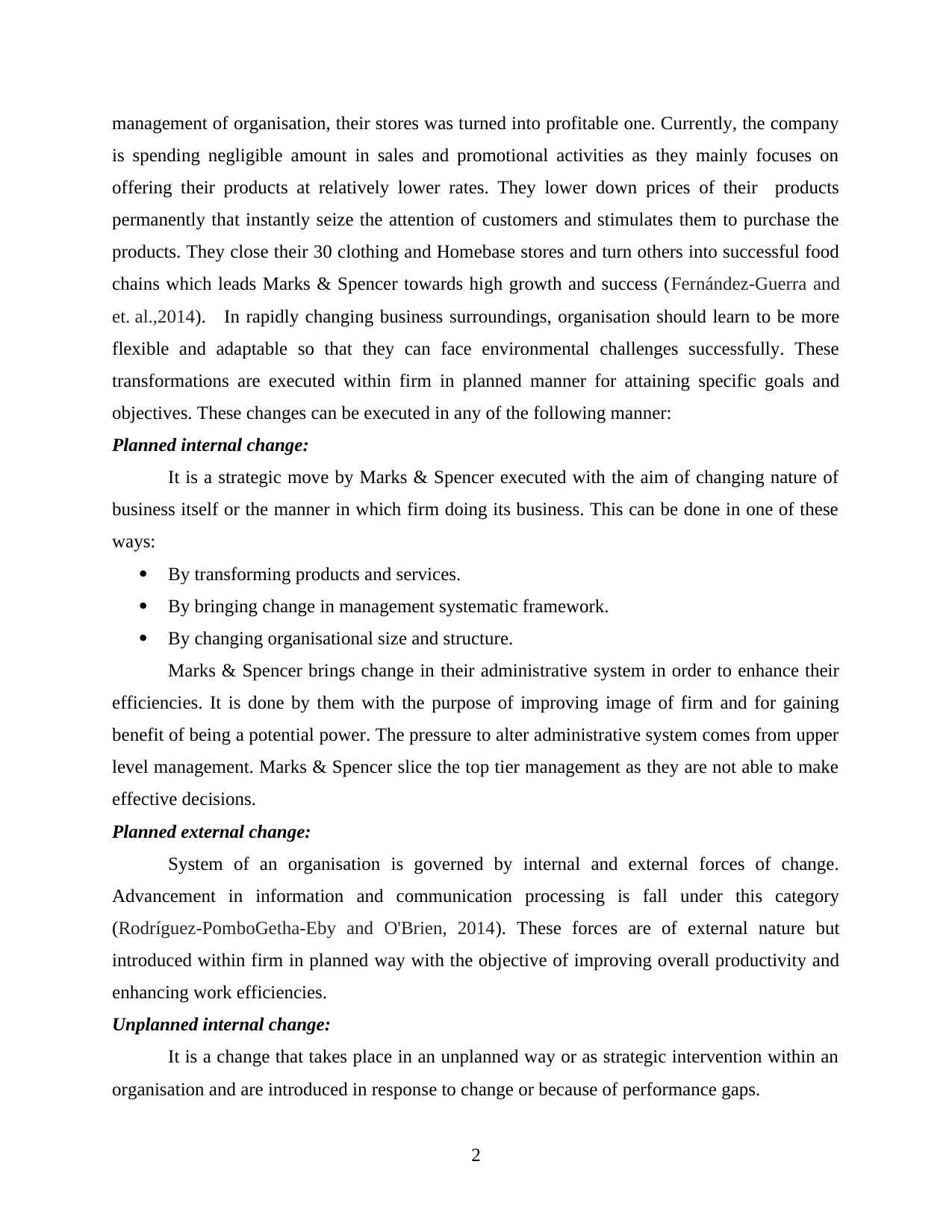
management of organisation, their stores was turned into profitable one. Currently, the company
is spending negligible amount in sales and promotional activities as they mainly focuses on
offering their products at relatively lower rates. They lower down prices of their products
permanently that instantly seize the attention of customers and stimulates them to purchase the
products. They close their 30 clothing and Homebase stores and turn others into successful food
chains which leads Marks & Spencer towards high growth and success (Fernández-Guerra and
et. al.,2014). In rapidly changing business surroundings, organisation should learn to be more
flexible and adaptable so that they can face environmental challenges successfully. These
transformations are executed within firm in planned manner for attaining specific goals and
objectives. These changes can be executed in any of the following manner:
Planned internal change:
It is a strategic move by Marks & Spencer executed with the aim of changing nature of
business itself or the manner in which firm doing its business. This can be done in one of these
ways:
By transforming products and services.
By bringing change in management systematic framework.
By changing organisational size and structure.
Marks & Spencer brings change in their administrative system in order to enhance their
efficiencies. It is done by them with the purpose of improving image of firm and for gaining
benefit of being a potential power. The pressure to alter administrative system comes from upper
level management. Marks & Spencer slice the top tier management as they are not able to make
effective decisions.
Planned external change:
System of an organisation is governed by internal and external forces of change.
Advancement in information and communication processing is fall under this category
(Rodríguez-PomboGetha-Eby and O'Brien, 2014). These forces are of external nature but
introduced within firm in planned way with the objective of improving overall productivity and
enhancing work efficiencies.
Unplanned internal change:
It is a change that takes place in an unplanned way or as strategic intervention within an
organisation and are introduced in response to change or because of performance gaps.
2
is spending negligible amount in sales and promotional activities as they mainly focuses on
offering their products at relatively lower rates. They lower down prices of their products
permanently that instantly seize the attention of customers and stimulates them to purchase the
products. They close their 30 clothing and Homebase stores and turn others into successful food
chains which leads Marks & Spencer towards high growth and success (Fernández-Guerra and
et. al.,2014). In rapidly changing business surroundings, organisation should learn to be more
flexible and adaptable so that they can face environmental challenges successfully. These
transformations are executed within firm in planned manner for attaining specific goals and
objectives. These changes can be executed in any of the following manner:
Planned internal change:
It is a strategic move by Marks & Spencer executed with the aim of changing nature of
business itself or the manner in which firm doing its business. This can be done in one of these
ways:
By transforming products and services.
By bringing change in management systematic framework.
By changing organisational size and structure.
Marks & Spencer brings change in their administrative system in order to enhance their
efficiencies. It is done by them with the purpose of improving image of firm and for gaining
benefit of being a potential power. The pressure to alter administrative system comes from upper
level management. Marks & Spencer slice the top tier management as they are not able to make
effective decisions.
Planned external change:
System of an organisation is governed by internal and external forces of change.
Advancement in information and communication processing is fall under this category
(Rodríguez-PomboGetha-Eby and O'Brien, 2014). These forces are of external nature but
introduced within firm in planned way with the objective of improving overall productivity and
enhancing work efficiencies.
Unplanned internal change:
It is a change that takes place in an unplanned way or as strategic intervention within an
organisation and are introduced in response to change or because of performance gaps.
2
Paraphrase This Document
Need a fresh take? Get an instant paraphrase of this document with our AI Paraphraser
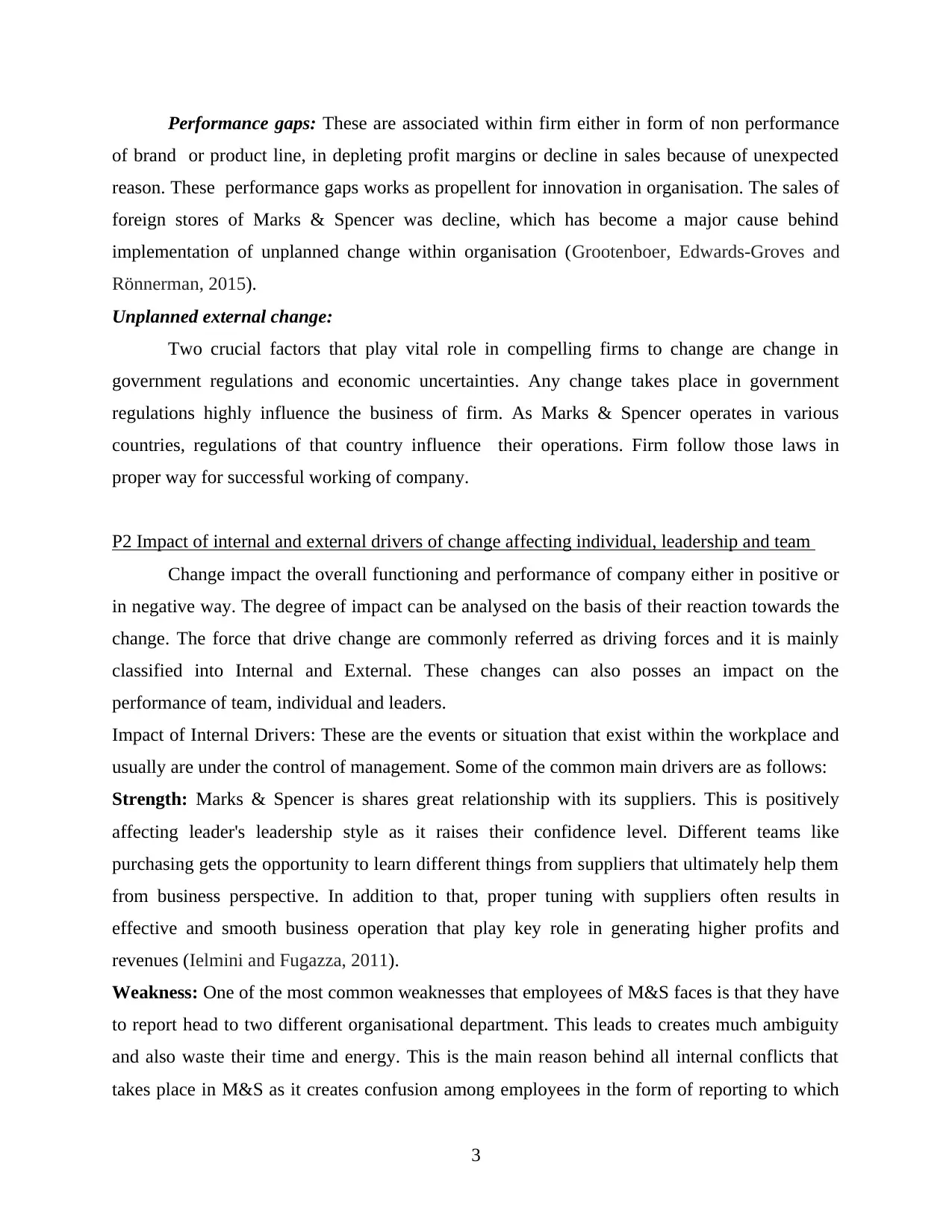
Performance gaps: These are associated within firm either in form of non performance
of brand or product line, in depleting profit margins or decline in sales because of unexpected
reason. These performance gaps works as propellent for innovation in organisation. The sales of
foreign stores of Marks & Spencer was decline, which has become a major cause behind
implementation of unplanned change within organisation (Grootenboer, Edwards-Groves and
Rönnerman, 2015).
Unplanned external change:
Two crucial factors that play vital role in compelling firms to change are change in
government regulations and economic uncertainties. Any change takes place in government
regulations highly influence the business of firm. As Marks & Spencer operates in various
countries, regulations of that country influence their operations. Firm follow those laws in
proper way for successful working of company.
P2 Impact of internal and external drivers of change affecting individual, leadership and team
Change impact the overall functioning and performance of company either in positive or
in negative way. The degree of impact can be analysed on the basis of their reaction towards the
change. The force that drive change are commonly referred as driving forces and it is mainly
classified into Internal and External. These changes can also posses an impact on the
performance of team, individual and leaders.
Impact of Internal Drivers: These are the events or situation that exist within the workplace and
usually are under the control of management. Some of the common main drivers are as follows:
Strength: Marks & Spencer is shares great relationship with its suppliers. This is positively
affecting leader's leadership style as it raises their confidence level. Different teams like
purchasing gets the opportunity to learn different things from suppliers that ultimately help them
from business perspective. In addition to that, proper tuning with suppliers often results in
effective and smooth business operation that play key role in generating higher profits and
revenues (Ielmini and Fugazza, 2011).
Weakness: One of the most common weaknesses that employees of M&S faces is that they have
to report head to two different organisational department. This leads to creates much ambiguity
and also waste their time and energy. This is the main reason behind all internal conflicts that
takes place in M&S as it creates confusion among employees in the form of reporting to which
3
of brand or product line, in depleting profit margins or decline in sales because of unexpected
reason. These performance gaps works as propellent for innovation in organisation. The sales of
foreign stores of Marks & Spencer was decline, which has become a major cause behind
implementation of unplanned change within organisation (Grootenboer, Edwards-Groves and
Rönnerman, 2015).
Unplanned external change:
Two crucial factors that play vital role in compelling firms to change are change in
government regulations and economic uncertainties. Any change takes place in government
regulations highly influence the business of firm. As Marks & Spencer operates in various
countries, regulations of that country influence their operations. Firm follow those laws in
proper way for successful working of company.
P2 Impact of internal and external drivers of change affecting individual, leadership and team
Change impact the overall functioning and performance of company either in positive or
in negative way. The degree of impact can be analysed on the basis of their reaction towards the
change. The force that drive change are commonly referred as driving forces and it is mainly
classified into Internal and External. These changes can also posses an impact on the
performance of team, individual and leaders.
Impact of Internal Drivers: These are the events or situation that exist within the workplace and
usually are under the control of management. Some of the common main drivers are as follows:
Strength: Marks & Spencer is shares great relationship with its suppliers. This is positively
affecting leader's leadership style as it raises their confidence level. Different teams like
purchasing gets the opportunity to learn different things from suppliers that ultimately help them
from business perspective. In addition to that, proper tuning with suppliers often results in
effective and smooth business operation that play key role in generating higher profits and
revenues (Ielmini and Fugazza, 2011).
Weakness: One of the most common weaknesses that employees of M&S faces is that they have
to report head to two different organisational department. This leads to creates much ambiguity
and also waste their time and energy. This is the main reason behind all internal conflicts that
takes place in M&S as it creates confusion among employees in the form of reporting to which
3
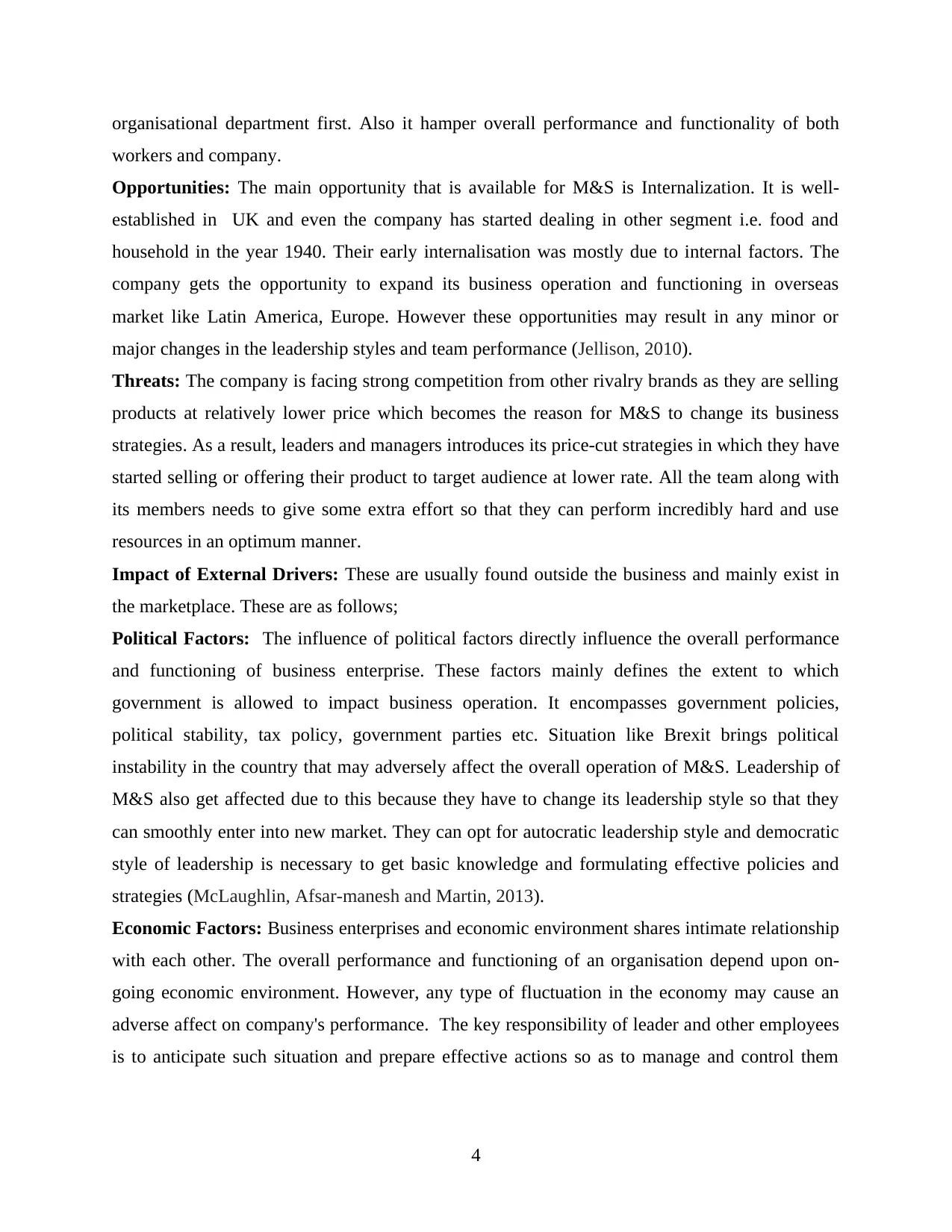
organisational department first. Also it hamper overall performance and functionality of both
workers and company.
Opportunities: The main opportunity that is available for M&S is Internalization. It is well-
established in UK and even the company has started dealing in other segment i.e. food and
household in the year 1940. Their early internalisation was mostly due to internal factors. The
company gets the opportunity to expand its business operation and functioning in overseas
market like Latin America, Europe. However these opportunities may result in any minor or
major changes in the leadership styles and team performance (Jellison, 2010).
Threats: The company is facing strong competition from other rivalry brands as they are selling
products at relatively lower price which becomes the reason for M&S to change its business
strategies. As a result, leaders and managers introduces its price-cut strategies in which they have
started selling or offering their product to target audience at lower rate. All the team along with
its members needs to give some extra effort so that they can perform incredibly hard and use
resources in an optimum manner.
Impact of External Drivers: These are usually found outside the business and mainly exist in
the marketplace. These are as follows;
Political Factors: The influence of political factors directly influence the overall performance
and functioning of business enterprise. These factors mainly defines the extent to which
government is allowed to impact business operation. It encompasses government policies,
political stability, tax policy, government parties etc. Situation like Brexit brings political
instability in the country that may adversely affect the overall operation of M&S. Leadership of
M&S also get affected due to this because they have to change its leadership style so that they
can smoothly enter into new market. They can opt for autocratic leadership style and democratic
style of leadership is necessary to get basic knowledge and formulating effective policies and
strategies (McLaughlin, Afsar-manesh and Martin, 2013).
Economic Factors: Business enterprises and economic environment shares intimate relationship
with each other. The overall performance and functioning of an organisation depend upon on-
going economic environment. However, any type of fluctuation in the economy may cause an
adverse affect on company's performance. The key responsibility of leader and other employees
is to anticipate such situation and prepare effective actions so as to manage and control them
4
workers and company.
Opportunities: The main opportunity that is available for M&S is Internalization. It is well-
established in UK and even the company has started dealing in other segment i.e. food and
household in the year 1940. Their early internalisation was mostly due to internal factors. The
company gets the opportunity to expand its business operation and functioning in overseas
market like Latin America, Europe. However these opportunities may result in any minor or
major changes in the leadership styles and team performance (Jellison, 2010).
Threats: The company is facing strong competition from other rivalry brands as they are selling
products at relatively lower price which becomes the reason for M&S to change its business
strategies. As a result, leaders and managers introduces its price-cut strategies in which they have
started selling or offering their product to target audience at lower rate. All the team along with
its members needs to give some extra effort so that they can perform incredibly hard and use
resources in an optimum manner.
Impact of External Drivers: These are usually found outside the business and mainly exist in
the marketplace. These are as follows;
Political Factors: The influence of political factors directly influence the overall performance
and functioning of business enterprise. These factors mainly defines the extent to which
government is allowed to impact business operation. It encompasses government policies,
political stability, tax policy, government parties etc. Situation like Brexit brings political
instability in the country that may adversely affect the overall operation of M&S. Leadership of
M&S also get affected due to this because they have to change its leadership style so that they
can smoothly enter into new market. They can opt for autocratic leadership style and democratic
style of leadership is necessary to get basic knowledge and formulating effective policies and
strategies (McLaughlin, Afsar-manesh and Martin, 2013).
Economic Factors: Business enterprises and economic environment shares intimate relationship
with each other. The overall performance and functioning of an organisation depend upon on-
going economic environment. However, any type of fluctuation in the economy may cause an
adverse affect on company's performance. The key responsibility of leader and other employees
is to anticipate such situation and prepare effective actions so as to manage and control them
4
⊘ This is a preview!⊘
Do you want full access?
Subscribe today to unlock all pages.

Trusted by 1+ million students worldwide
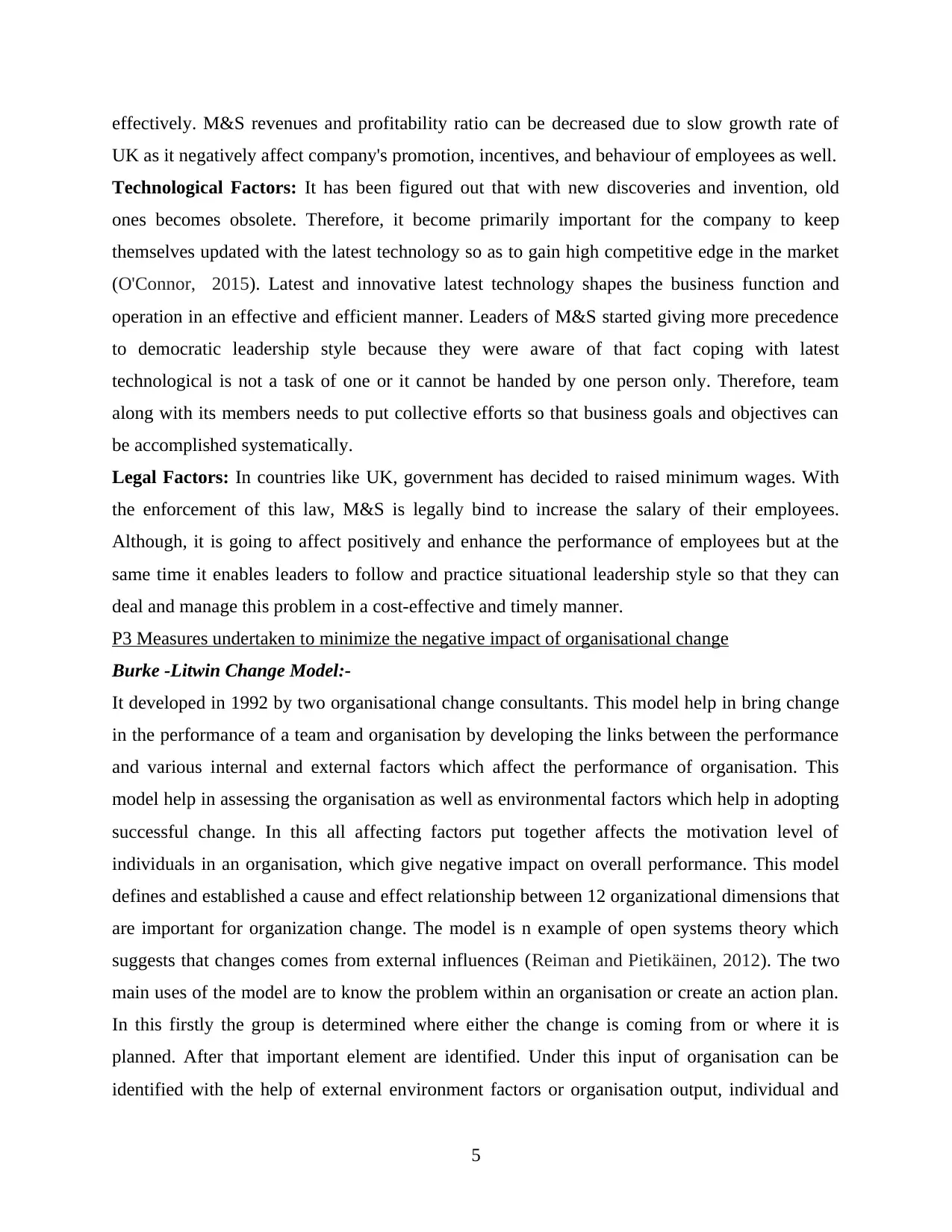
effectively. M&S revenues and profitability ratio can be decreased due to slow growth rate of
UK as it negatively affect company's promotion, incentives, and behaviour of employees as well.
Technological Factors: It has been figured out that with new discoveries and invention, old
ones becomes obsolete. Therefore, it become primarily important for the company to keep
themselves updated with the latest technology so as to gain high competitive edge in the market
(O'Connor, 2015). Latest and innovative latest technology shapes the business function and
operation in an effective and efficient manner. Leaders of M&S started giving more precedence
to democratic leadership style because they were aware of that fact coping with latest
technological is not a task of one or it cannot be handed by one person only. Therefore, team
along with its members needs to put collective efforts so that business goals and objectives can
be accomplished systematically.
Legal Factors: In countries like UK, government has decided to raised minimum wages. With
the enforcement of this law, M&S is legally bind to increase the salary of their employees.
Although, it is going to affect positively and enhance the performance of employees but at the
same time it enables leaders to follow and practice situational leadership style so that they can
deal and manage this problem in a cost-effective and timely manner.
P3 Measures undertaken to minimize the negative impact of organisational change
Burke -Litwin Change Model:-
It developed in 1992 by two organisational change consultants. This model help in bring change
in the performance of a team and organisation by developing the links between the performance
and various internal and external factors which affect the performance of organisation. This
model help in assessing the organisation as well as environmental factors which help in adopting
successful change. In this all affecting factors put together affects the motivation level of
individuals in an organisation, which give negative impact on overall performance. This model
defines and established a cause and effect relationship between 12 organizational dimensions that
are important for organization change. The model is n example of open systems theory which
suggests that changes comes from external influences (Reiman and Pietikäinen, 2012). The two
main uses of the model are to know the problem within an organisation or create an action plan.
In this firstly the group is determined where either the change is coming from or where it is
planned. After that important element are identified. Under this input of organisation can be
identified with the help of external environment factors or organisation output, individual and
5
UK as it negatively affect company's promotion, incentives, and behaviour of employees as well.
Technological Factors: It has been figured out that with new discoveries and invention, old
ones becomes obsolete. Therefore, it become primarily important for the company to keep
themselves updated with the latest technology so as to gain high competitive edge in the market
(O'Connor, 2015). Latest and innovative latest technology shapes the business function and
operation in an effective and efficient manner. Leaders of M&S started giving more precedence
to democratic leadership style because they were aware of that fact coping with latest
technological is not a task of one or it cannot be handed by one person only. Therefore, team
along with its members needs to put collective efforts so that business goals and objectives can
be accomplished systematically.
Legal Factors: In countries like UK, government has decided to raised minimum wages. With
the enforcement of this law, M&S is legally bind to increase the salary of their employees.
Although, it is going to affect positively and enhance the performance of employees but at the
same time it enables leaders to follow and practice situational leadership style so that they can
deal and manage this problem in a cost-effective and timely manner.
P3 Measures undertaken to minimize the negative impact of organisational change
Burke -Litwin Change Model:-
It developed in 1992 by two organisational change consultants. This model help in bring change
in the performance of a team and organisation by developing the links between the performance
and various internal and external factors which affect the performance of organisation. This
model help in assessing the organisation as well as environmental factors which help in adopting
successful change. In this all affecting factors put together affects the motivation level of
individuals in an organisation, which give negative impact on overall performance. This model
defines and established a cause and effect relationship between 12 organizational dimensions that
are important for organization change. The model is n example of open systems theory which
suggests that changes comes from external influences (Reiman and Pietikäinen, 2012). The two
main uses of the model are to know the problem within an organisation or create an action plan.
In this firstly the group is determined where either the change is coming from or where it is
planned. After that important element are identified. Under this input of organisation can be
identified with the help of external environment factors or organisation output, individual and
5
Paraphrase This Document
Need a fresh take? Get an instant paraphrase of this document with our AI Paraphraser
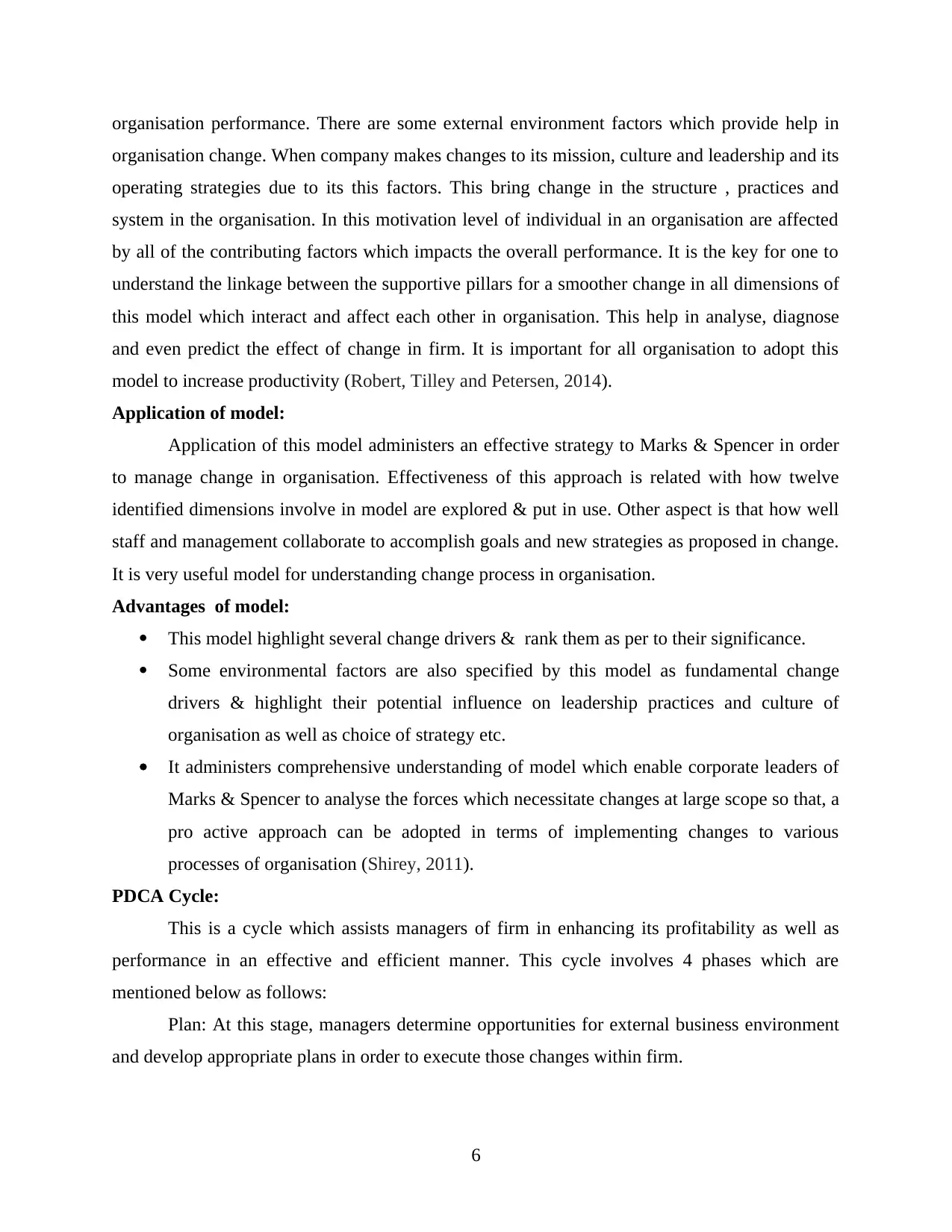
organisation performance. There are some external environment factors which provide help in
organisation change. When company makes changes to its mission, culture and leadership and its
operating strategies due to its this factors. This bring change in the structure , practices and
system in the organisation. In this motivation level of individual in an organisation are affected
by all of the contributing factors which impacts the overall performance. It is the key for one to
understand the linkage between the supportive pillars for a smoother change in all dimensions of
this model which interact and affect each other in organisation. This help in analyse, diagnose
and even predict the effect of change in firm. It is important for all organisation to adopt this
model to increase productivity (Robert, Tilley and Petersen, 2014).
Application of model:
Application of this model administers an effective strategy to Marks & Spencer in order
to manage change in organisation. Effectiveness of this approach is related with how twelve
identified dimensions involve in model are explored & put in use. Other aspect is that how well
staff and management collaborate to accomplish goals and new strategies as proposed in change.
It is very useful model for understanding change process in organisation.
Advantages of model:
This model highlight several change drivers & rank them as per to their significance.
Some environmental factors are also specified by this model as fundamental change
drivers & highlight their potential influence on leadership practices and culture of
organisation as well as choice of strategy etc.
It administers comprehensive understanding of model which enable corporate leaders of
Marks & Spencer to analyse the forces which necessitate changes at large scope so that, a
pro active approach can be adopted in terms of implementing changes to various
processes of organisation (Shirey, 2011).
PDCA Cycle:
This is a cycle which assists managers of firm in enhancing its profitability as well as
performance in an effective and efficient manner. This cycle involves 4 phases which are
mentioned below as follows:
Plan: At this stage, managers determine opportunities for external business environment
and develop appropriate plans in order to execute those changes within firm.
6
organisation change. When company makes changes to its mission, culture and leadership and its
operating strategies due to its this factors. This bring change in the structure , practices and
system in the organisation. In this motivation level of individual in an organisation are affected
by all of the contributing factors which impacts the overall performance. It is the key for one to
understand the linkage between the supportive pillars for a smoother change in all dimensions of
this model which interact and affect each other in organisation. This help in analyse, diagnose
and even predict the effect of change in firm. It is important for all organisation to adopt this
model to increase productivity (Robert, Tilley and Petersen, 2014).
Application of model:
Application of this model administers an effective strategy to Marks & Spencer in order
to manage change in organisation. Effectiveness of this approach is related with how twelve
identified dimensions involve in model are explored & put in use. Other aspect is that how well
staff and management collaborate to accomplish goals and new strategies as proposed in change.
It is very useful model for understanding change process in organisation.
Advantages of model:
This model highlight several change drivers & rank them as per to their significance.
Some environmental factors are also specified by this model as fundamental change
drivers & highlight their potential influence on leadership practices and culture of
organisation as well as choice of strategy etc.
It administers comprehensive understanding of model which enable corporate leaders of
Marks & Spencer to analyse the forces which necessitate changes at large scope so that, a
pro active approach can be adopted in terms of implementing changes to various
processes of organisation (Shirey, 2011).
PDCA Cycle:
This is a cycle which assists managers of firm in enhancing its profitability as well as
performance in an effective and efficient manner. This cycle involves 4 phases which are
mentioned below as follows:
Plan: At this stage, managers determine opportunities for external business environment
and develop appropriate plans in order to execute those changes within firm.
6
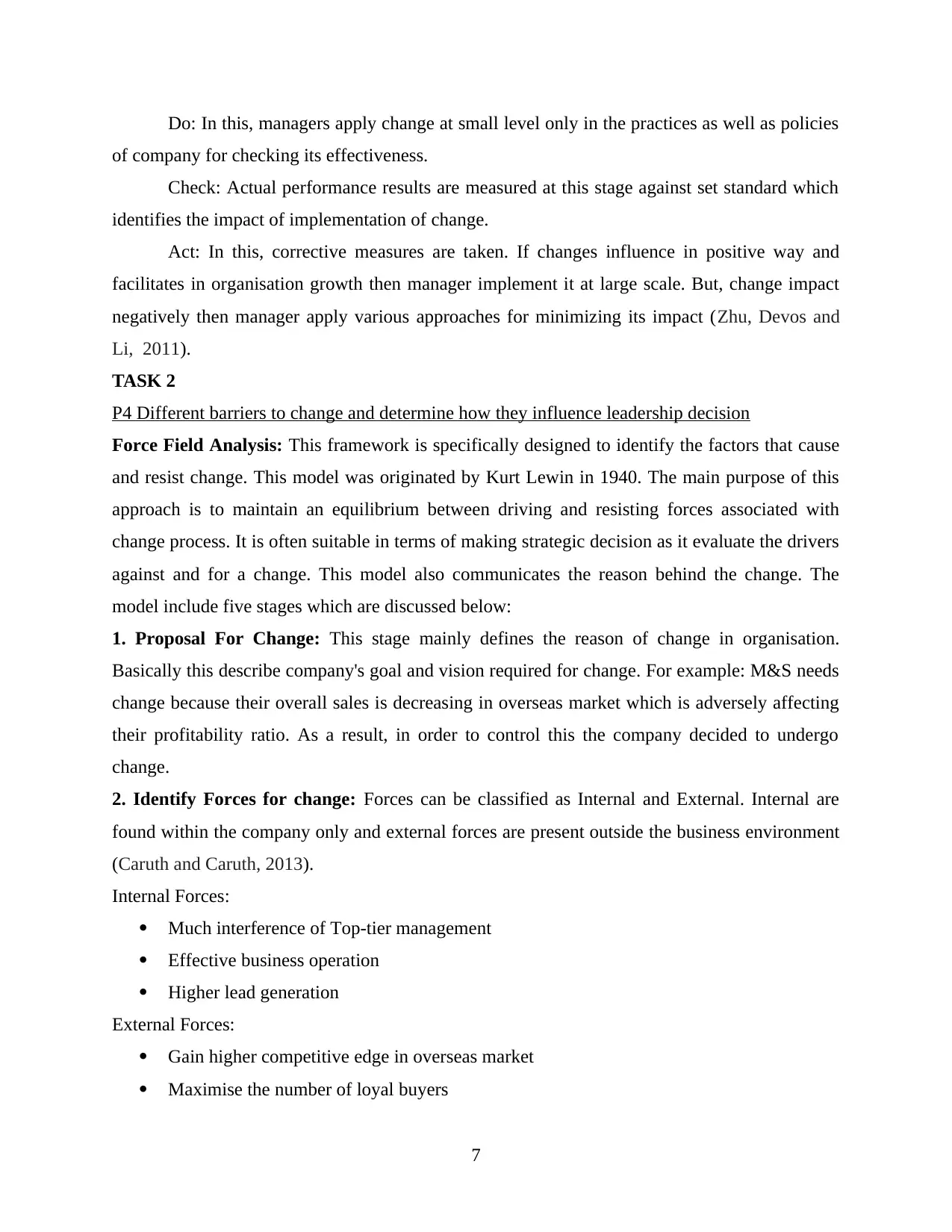
Do: In this, managers apply change at small level only in the practices as well as policies
of company for checking its effectiveness.
Check: Actual performance results are measured at this stage against set standard which
identifies the impact of implementation of change.
Act: In this, corrective measures are taken. If changes influence in positive way and
facilitates in organisation growth then manager implement it at large scale. But, change impact
negatively then manager apply various approaches for minimizing its impact (Zhu, Devos and
Li, 2011).
TASK 2
P4 Different barriers to change and determine how they influence leadership decision
Force Field Analysis: This framework is specifically designed to identify the factors that cause
and resist change. This model was originated by Kurt Lewin in 1940. The main purpose of this
approach is to maintain an equilibrium between driving and resisting forces associated with
change process. It is often suitable in terms of making strategic decision as it evaluate the drivers
against and for a change. This model also communicates the reason behind the change. The
model include five stages which are discussed below:
1. Proposal For Change: This stage mainly defines the reason of change in organisation.
Basically this describe company's goal and vision required for change. For example: M&S needs
change because their overall sales is decreasing in overseas market which is adversely affecting
their profitability ratio. As a result, in order to control this the company decided to undergo
change.
2. Identify Forces for change: Forces can be classified as Internal and External. Internal are
found within the company only and external forces are present outside the business environment
(Caruth and Caruth, 2013).
Internal Forces:
Much interference of Top-tier management
Effective business operation
Higher lead generation
External Forces:
Gain higher competitive edge in overseas market
Maximise the number of loyal buyers
7
of company for checking its effectiveness.
Check: Actual performance results are measured at this stage against set standard which
identifies the impact of implementation of change.
Act: In this, corrective measures are taken. If changes influence in positive way and
facilitates in organisation growth then manager implement it at large scale. But, change impact
negatively then manager apply various approaches for minimizing its impact (Zhu, Devos and
Li, 2011).
TASK 2
P4 Different barriers to change and determine how they influence leadership decision
Force Field Analysis: This framework is specifically designed to identify the factors that cause
and resist change. This model was originated by Kurt Lewin in 1940. The main purpose of this
approach is to maintain an equilibrium between driving and resisting forces associated with
change process. It is often suitable in terms of making strategic decision as it evaluate the drivers
against and for a change. This model also communicates the reason behind the change. The
model include five stages which are discussed below:
1. Proposal For Change: This stage mainly defines the reason of change in organisation.
Basically this describe company's goal and vision required for change. For example: M&S needs
change because their overall sales is decreasing in overseas market which is adversely affecting
their profitability ratio. As a result, in order to control this the company decided to undergo
change.
2. Identify Forces for change: Forces can be classified as Internal and External. Internal are
found within the company only and external forces are present outside the business environment
(Caruth and Caruth, 2013).
Internal Forces:
Much interference of Top-tier management
Effective business operation
Higher lead generation
External Forces:
Gain higher competitive edge in overseas market
Maximise the number of loyal buyers
7
⊘ This is a preview!⊘
Do you want full access?
Subscribe today to unlock all pages.

Trusted by 1+ million students worldwide
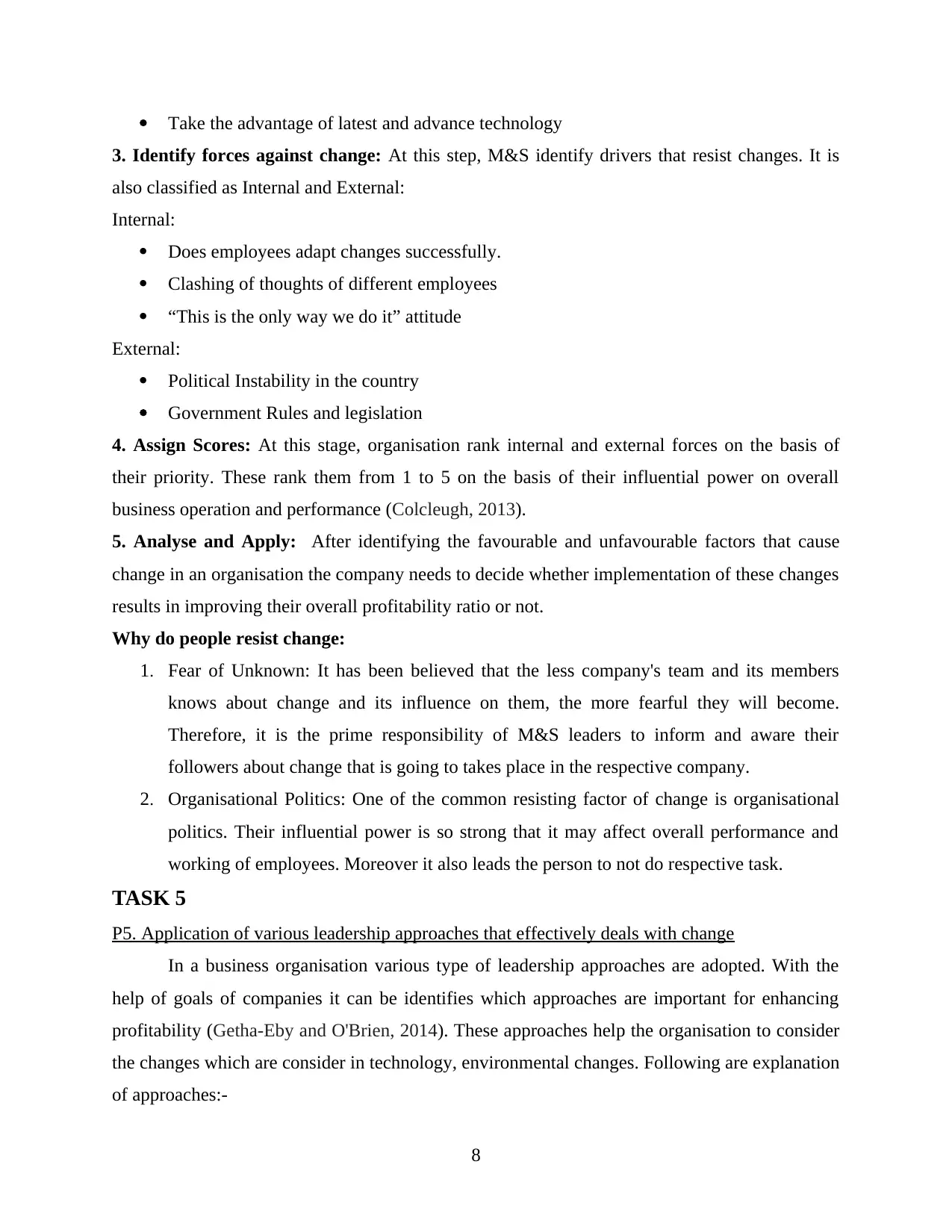
Take the advantage of latest and advance technology
3. Identify forces against change: At this step, M&S identify drivers that resist changes. It is
also classified as Internal and External:
Internal:
Does employees adapt changes successfully.
Clashing of thoughts of different employees
“This is the only way we do it” attitude
External:
Political Instability in the country
Government Rules and legislation
4. Assign Scores: At this stage, organisation rank internal and external forces on the basis of
their priority. These rank them from 1 to 5 on the basis of their influential power on overall
business operation and performance (Colcleugh, 2013).
5. Analyse and Apply: After identifying the favourable and unfavourable factors that cause
change in an organisation the company needs to decide whether implementation of these changes
results in improving their overall profitability ratio or not.
Why do people resist change:
1. Fear of Unknown: It has been believed that the less company's team and its members
knows about change and its influence on them, the more fearful they will become.
Therefore, it is the prime responsibility of M&S leaders to inform and aware their
followers about change that is going to takes place in the respective company.
2. Organisational Politics: One of the common resisting factor of change is organisational
politics. Their influential power is so strong that it may affect overall performance and
working of employees. Moreover it also leads the person to not do respective task.
TASK 5
P5. Application of various leadership approaches that effectively deals with change
In a business organisation various type of leadership approaches are adopted. With the
help of goals of companies it can be identifies which approaches are important for enhancing
profitability (Getha-Eby and O'Brien, 2014). These approaches help the organisation to consider
the changes which are consider in technology, environmental changes. Following are explanation
of approaches:-
8
3. Identify forces against change: At this step, M&S identify drivers that resist changes. It is
also classified as Internal and External:
Internal:
Does employees adapt changes successfully.
Clashing of thoughts of different employees
“This is the only way we do it” attitude
External:
Political Instability in the country
Government Rules and legislation
4. Assign Scores: At this stage, organisation rank internal and external forces on the basis of
their priority. These rank them from 1 to 5 on the basis of their influential power on overall
business operation and performance (Colcleugh, 2013).
5. Analyse and Apply: After identifying the favourable and unfavourable factors that cause
change in an organisation the company needs to decide whether implementation of these changes
results in improving their overall profitability ratio or not.
Why do people resist change:
1. Fear of Unknown: It has been believed that the less company's team and its members
knows about change and its influence on them, the more fearful they will become.
Therefore, it is the prime responsibility of M&S leaders to inform and aware their
followers about change that is going to takes place in the respective company.
2. Organisational Politics: One of the common resisting factor of change is organisational
politics. Their influential power is so strong that it may affect overall performance and
working of employees. Moreover it also leads the person to not do respective task.
TASK 5
P5. Application of various leadership approaches that effectively deals with change
In a business organisation various type of leadership approaches are adopted. With the
help of goals of companies it can be identifies which approaches are important for enhancing
profitability (Getha-Eby and O'Brien, 2014). These approaches help the organisation to consider
the changes which are consider in technology, environmental changes. Following are explanation
of approaches:-
8
Paraphrase This Document
Need a fresh take? Get an instant paraphrase of this document with our AI Paraphraser
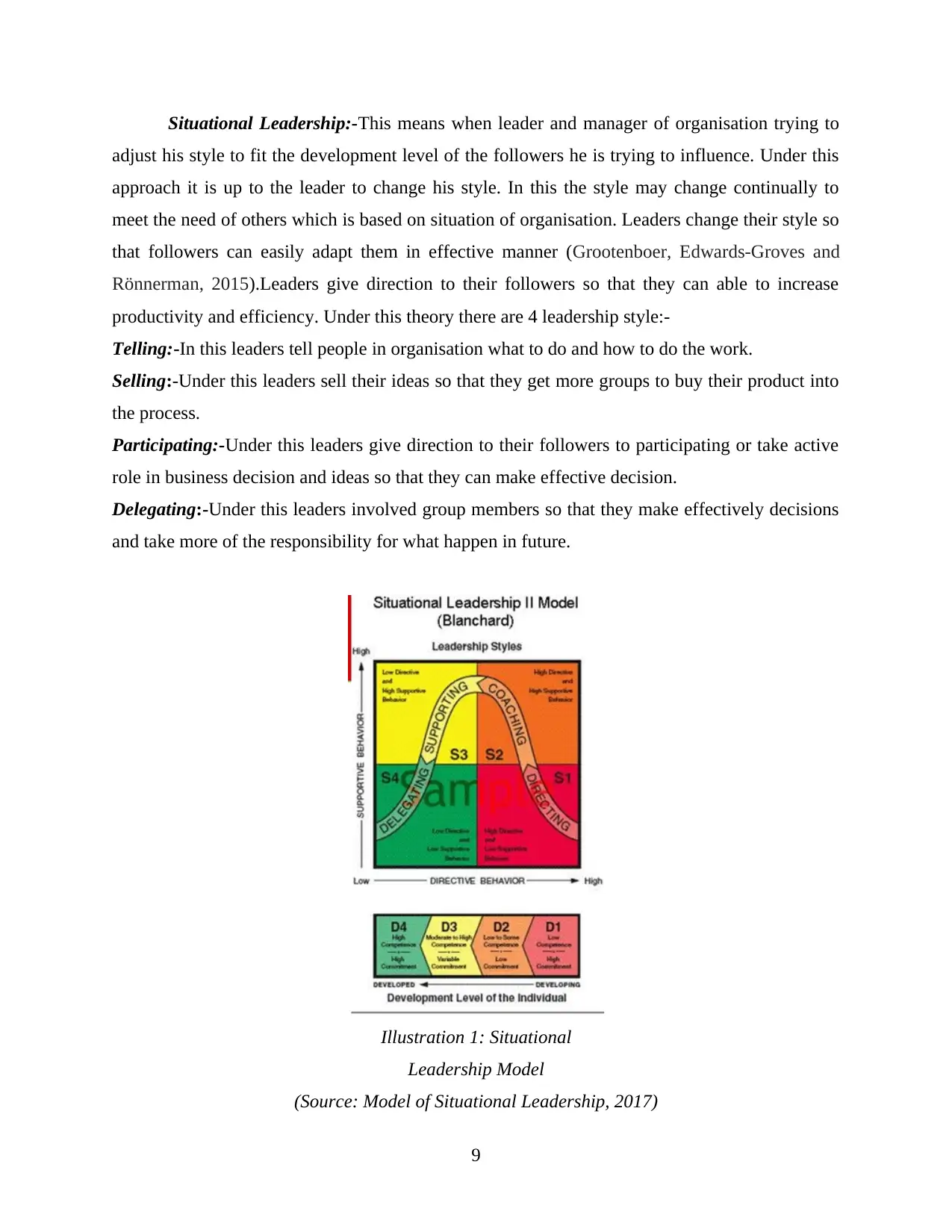
Situational Leadership:-This means when leader and manager of organisation trying to
adjust his style to fit the development level of the followers he is trying to influence. Under this
approach it is up to the leader to change his style. In this the style may change continually to
meet the need of others which is based on situation of organisation. Leaders change their style so
that followers can easily adapt them in effective manner (Grootenboer, Edwards-Groves and
Rönnerman, 2015).Leaders give direction to their followers so that they can able to increase
productivity and efficiency. Under this theory there are 4 leadership style:-
Telling:-In this leaders tell people in organisation what to do and how to do the work.
Selling:-Under this leaders sell their ideas so that they get more groups to buy their product into
the process.
Participating:-Under this leaders give direction to their followers to participating or take active
role in business decision and ideas so that they can make effective decision.
Delegating:-Under this leaders involved group members so that they make effectively decisions
and take more of the responsibility for what happen in future.
Illustration 1: Situational
Leadership Model
(Source: Model of Situational Leadership, 2017)
9
adjust his style to fit the development level of the followers he is trying to influence. Under this
approach it is up to the leader to change his style. In this the style may change continually to
meet the need of others which is based on situation of organisation. Leaders change their style so
that followers can easily adapt them in effective manner (Grootenboer, Edwards-Groves and
Rönnerman, 2015).Leaders give direction to their followers so that they can able to increase
productivity and efficiency. Under this theory there are 4 leadership style:-
Telling:-In this leaders tell people in organisation what to do and how to do the work.
Selling:-Under this leaders sell their ideas so that they get more groups to buy their product into
the process.
Participating:-Under this leaders give direction to their followers to participating or take active
role in business decision and ideas so that they can make effective decision.
Delegating:-Under this leaders involved group members so that they make effectively decisions
and take more of the responsibility for what happen in future.
Illustration 1: Situational
Leadership Model
(Source: Model of Situational Leadership, 2017)
9
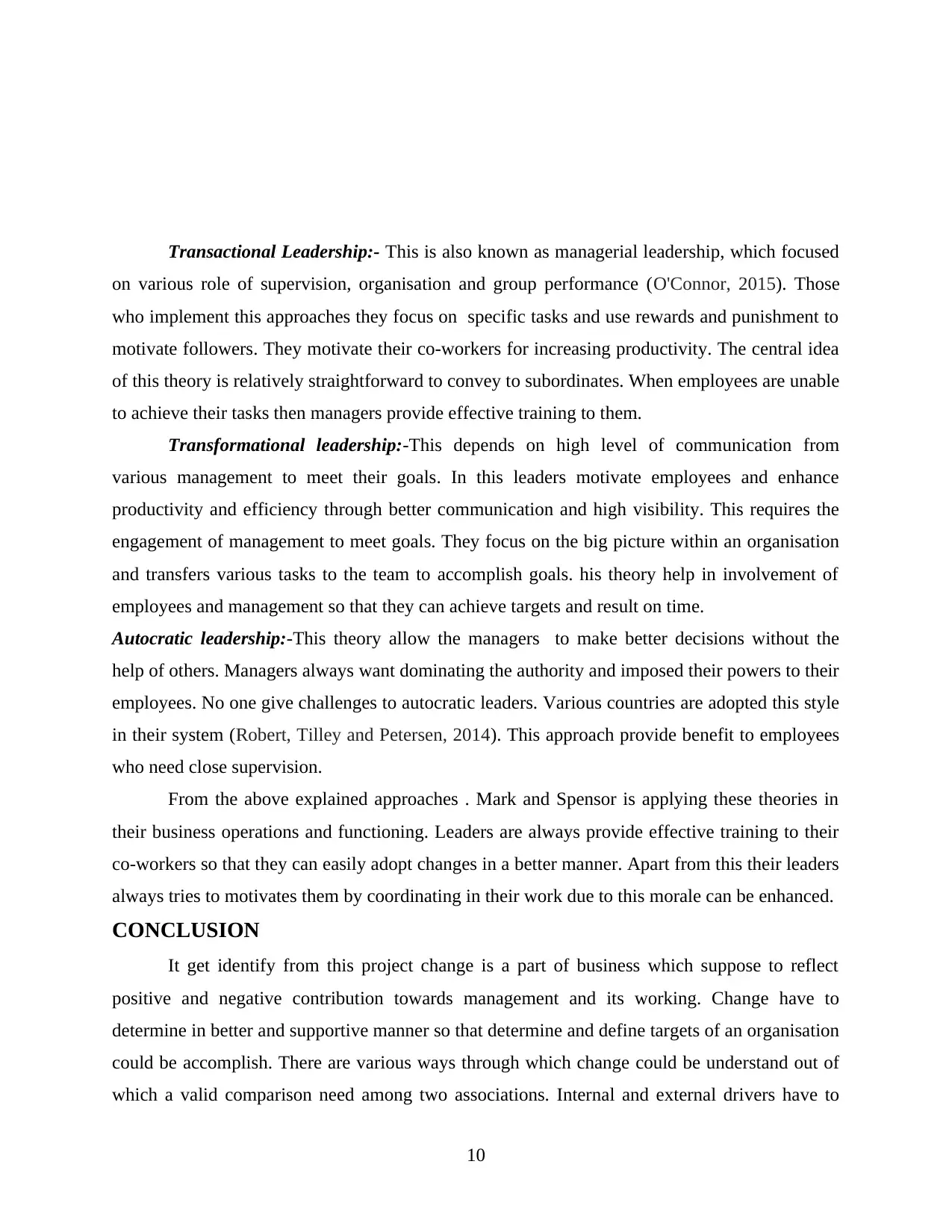
Transactional Leadership:- This is also known as managerial leadership, which focused
on various role of supervision, organisation and group performance (O'Connor, 2015). Those
who implement this approaches they focus on specific tasks and use rewards and punishment to
motivate followers. They motivate their co-workers for increasing productivity. The central idea
of this theory is relatively straightforward to convey to subordinates. When employees are unable
to achieve their tasks then managers provide effective training to them.
Transformational leadership:-This depends on high level of communication from
various management to meet their goals. In this leaders motivate employees and enhance
productivity and efficiency through better communication and high visibility. This requires the
engagement of management to meet goals. They focus on the big picture within an organisation
and transfers various tasks to the team to accomplish goals. his theory help in involvement of
employees and management so that they can achieve targets and result on time.
Autocratic leadership:-This theory allow the managers to make better decisions without the
help of others. Managers always want dominating the authority and imposed their powers to their
employees. No one give challenges to autocratic leaders. Various countries are adopted this style
in their system (Robert, Tilley and Petersen, 2014). This approach provide benefit to employees
who need close supervision.
From the above explained approaches . Mark and Spensor is applying these theories in
their business operations and functioning. Leaders are always provide effective training to their
co-workers so that they can easily adopt changes in a better manner. Apart from this their leaders
always tries to motivates them by coordinating in their work due to this morale can be enhanced.
CONCLUSION
It get identify from this project change is a part of business which suppose to reflect
positive and negative contribution towards management and its working. Change have to
determine in better and supportive manner so that determine and define targets of an organisation
could be accomplish. There are various ways through which change could be understand out of
which a valid comparison need among two associations. Internal and external drivers have to
10
on various role of supervision, organisation and group performance (O'Connor, 2015). Those
who implement this approaches they focus on specific tasks and use rewards and punishment to
motivate followers. They motivate their co-workers for increasing productivity. The central idea
of this theory is relatively straightforward to convey to subordinates. When employees are unable
to achieve their tasks then managers provide effective training to them.
Transformational leadership:-This depends on high level of communication from
various management to meet their goals. In this leaders motivate employees and enhance
productivity and efficiency through better communication and high visibility. This requires the
engagement of management to meet goals. They focus on the big picture within an organisation
and transfers various tasks to the team to accomplish goals. his theory help in involvement of
employees and management so that they can achieve targets and result on time.
Autocratic leadership:-This theory allow the managers to make better decisions without the
help of others. Managers always want dominating the authority and imposed their powers to their
employees. No one give challenges to autocratic leaders. Various countries are adopted this style
in their system (Robert, Tilley and Petersen, 2014). This approach provide benefit to employees
who need close supervision.
From the above explained approaches . Mark and Spensor is applying these theories in
their business operations and functioning. Leaders are always provide effective training to their
co-workers so that they can easily adopt changes in a better manner. Apart from this their leaders
always tries to motivates them by coordinating in their work due to this morale can be enhanced.
CONCLUSION
It get identify from this project change is a part of business which suppose to reflect
positive and negative contribution towards management and its working. Change have to
determine in better and supportive manner so that determine and define targets of an organisation
could be accomplish. There are various ways through which change could be understand out of
which a valid comparison need among two associations. Internal and external drivers have to
10
⊘ This is a preview!⊘
Do you want full access?
Subscribe today to unlock all pages.

Trusted by 1+ million students worldwide
1 out of 15
Related Documents
Your All-in-One AI-Powered Toolkit for Academic Success.
+13062052269
info@desklib.com
Available 24*7 on WhatsApp / Email
![[object Object]](/_next/static/media/star-bottom.7253800d.svg)
Unlock your academic potential
Copyright © 2020–2025 A2Z Services. All Rights Reserved. Developed and managed by ZUCOL.




